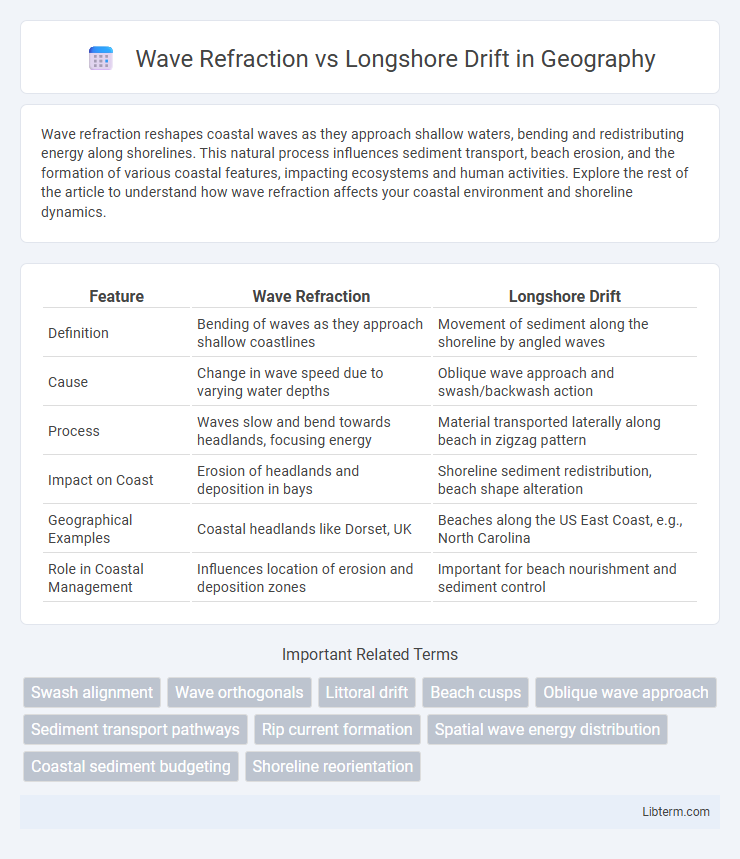Wave refraction reshapes coastal waves as they approach shallow waters, bending and redistributing energy along shorelines. This natural process influences sediment transport, beach erosion, and the formation of various coastal features, impacting ecosystems and human activities. Explore the rest of the article to understand how wave refraction affects your coastal environment and shoreline dynamics.
Table of Comparison
| Feature | Wave Refraction | Longshore Drift |
|---|---|---|
| Definition | Bending of waves as they approach shallow coastlines | Movement of sediment along the shoreline by angled waves |
| Cause | Change in wave speed due to varying water depths | Oblique wave approach and swash/backwash action |
| Process | Waves slow and bend towards headlands, focusing energy | Material transported laterally along beach in zigzag pattern |
| Impact on Coast | Erosion of headlands and deposition in bays | Shoreline sediment redistribution, beach shape alteration |
| Geographical Examples | Coastal headlands like Dorset, UK | Beaches along the US East Coast, e.g., North Carolina |
| Role in Coastal Management | Influences location of erosion and deposition zones | Important for beach nourishment and sediment control |
Introduction to Coastal Processes
Wave refraction bends incoming waves toward irregular coastlines, concentrating energy on headlands and dispersing it in bays, shaping erosional and depositional patterns along shorelines. Longshore drift transports sediment parallel to the coast, driven by oblique wave approach angles, resulting in the redistribution of sand and the formation of features like spits and barrier islands. These processes collectively influence coastal morphology, sediment budgets, and beach stability.
Understanding Wave Refraction
Wave refraction occurs when ocean waves approach the shoreline at an angle and slow down due to decreasing water depth, causing the wave fronts to bend and align more parallel to the coast. This bending concentrates wave energy on headlands and disperses it in bays, significantly influencing coastal erosion and sediment transport patterns. Understanding wave refraction is crucial for predicting how longshore drift redistributes sediment along the shore, shaping beaches and coastal landforms.
The Mechanics of Longshore Drift
Longshore drift occurs as waves approach the shore at an angle, causing the swash to carry sediment diagonally up the beach while the backwash pulls it directly down due to gravity. This zigzag movement results in the lateral transport of sand and pebbles along the coastline. Wave refraction bends wave fronts toward shallow areas, intensifying energy near headlands and influencing the direction and strength of longshore drift.
Key Differences Between Wave Refraction and Longshore Drift
Wave refraction occurs when waves bend as they approach shallow coastal areas, concentrating energy on headlands and dispersing it in bays, affecting sediment deposition and erosion patterns. Longshore drift involves the movement of sediment along the coastline caused by angled wave action, transporting sand and materials parallel to the shore. Key differences include wave refraction primarily altering wave energy distribution and coastal shaping, while longshore drift directly moves sediments along the beach, influencing beach morphology and shoreline alignment.
Factors Influencing Wave Refraction
Wave refraction is primarily influenced by variations in water depth and the shape of the seafloor, causing waves to bend as they approach the coastline. Changes in the underwater topography, such as reefs, sandbanks, and headlands, alter wave speed and direction, concentrating energy on protruding areas and dispersing it in bays. These factors critically affect sediment transport patterns, distinguishing wave refraction from longshore drift, which is driven by angled wave approach and current along the shore.
Elements Affecting Longshore Drift
Wave refraction influences the direction and energy distribution of incoming waves, which directly affects sediment transport along the shoreline. Key elements affecting longshore drift include wave angle, wave energy, shoreline shape, sediment size, and tidal range, all of which determine the volume and direction of sediment movement. Variations in coastal structures, such as groynes and jetties, also alter natural longshore drift patterns, impacting beach erosion and deposition processes.
Impact on Coastal Erosion and Deposition
Wave refraction concentrates wave energy on headlands, accelerating coastal erosion by breaking down rock formations and cliffs. Longshore drift transports sediment parallel to the shore, causing deposition in sheltered bays or along beaches, reshaping the coastline. The interplay of wave refraction and longshore drift dictates sediment distribution, impacting erosion rates and beach morphology.
Real-World Examples of Wave Refraction and Longshore Drift
Wave refraction is prominently observed along the curved coastlines of Hawaii, where incoming waves bend and concentrate energy on headlands, causing increased erosion and sediment deposition in bays. Longshore drift significantly shapes the east coast of England, particularly at Spurn Point, where sediment transported by angled wave action creates extensive spits and barrier islands. Both processes illustrate dynamic coastal evolution, with wave refraction focusing wave energy and longshore drift redistributing sediments parallel to the shoreline.
Human Interventions and Coastal Management
Human interventions such as the construction of groynes, breakwaters, and seawalls significantly influence wave refraction and longshore drift by altering natural sediment transport along coastlines. Coastal management strategies often harness wave refraction patterns to design structures that minimize erosion and promote beach nourishment while controlling longshore drift to stabilize shorelines. Effective integration of these processes supports sustainable shoreline protection and reduces the impact of erosion on human settlements and infrastructure.
Conclusion: Interplay Between Wave Refraction and Longshore Drift
Wave refraction shapes the angle at which waves approach the shore, influencing sediment deposition patterns and controlling the energy distribution along the coastline. Longshore drift transports sediment parallel to the shore, driven by the oblique wave approach shaped by wave refraction. The interplay between wave refraction and longshore drift determines coastal morphology, sediment budgets, and beach stability.
Wave Refraction Infographic

 libterm.com
libterm.com